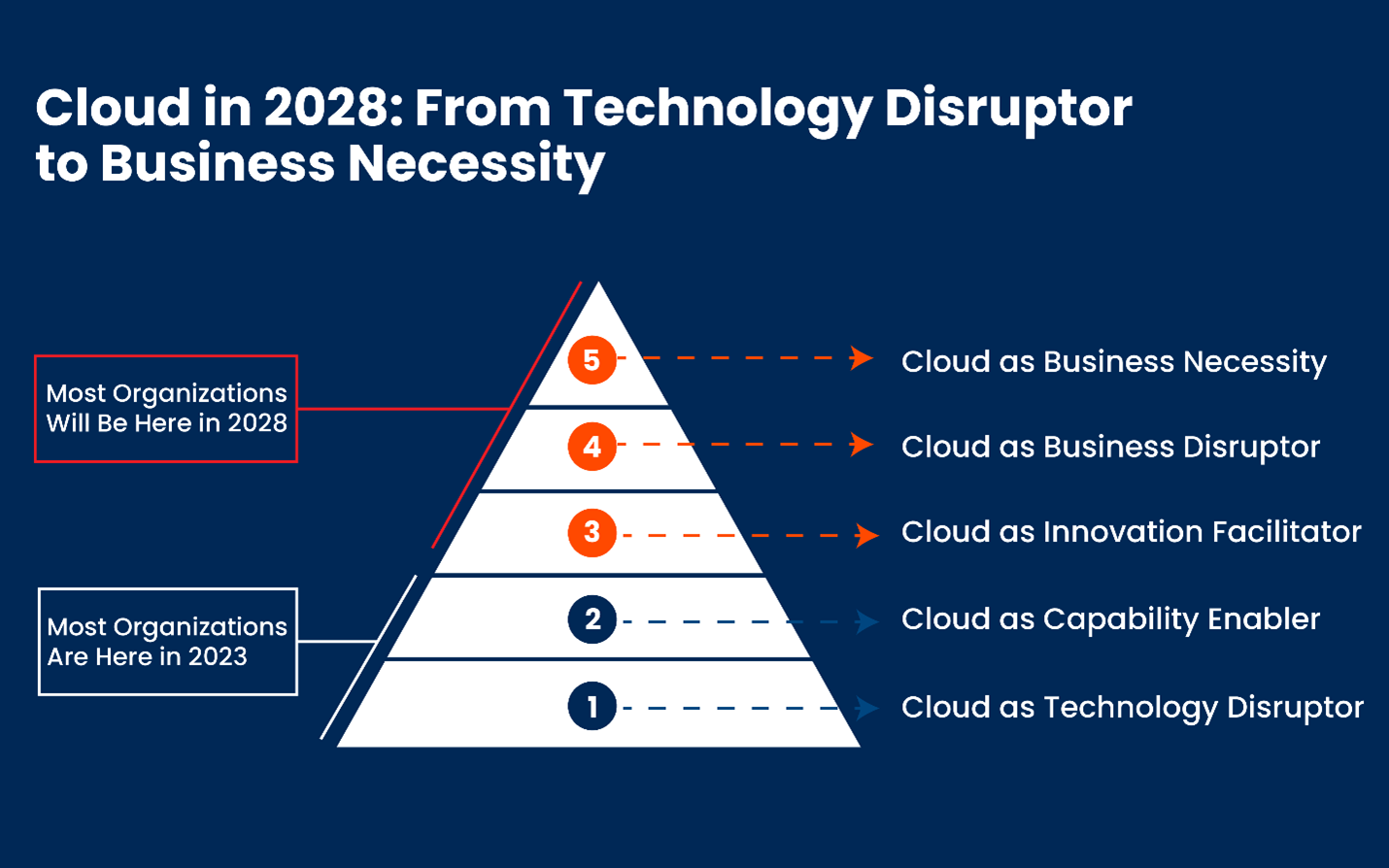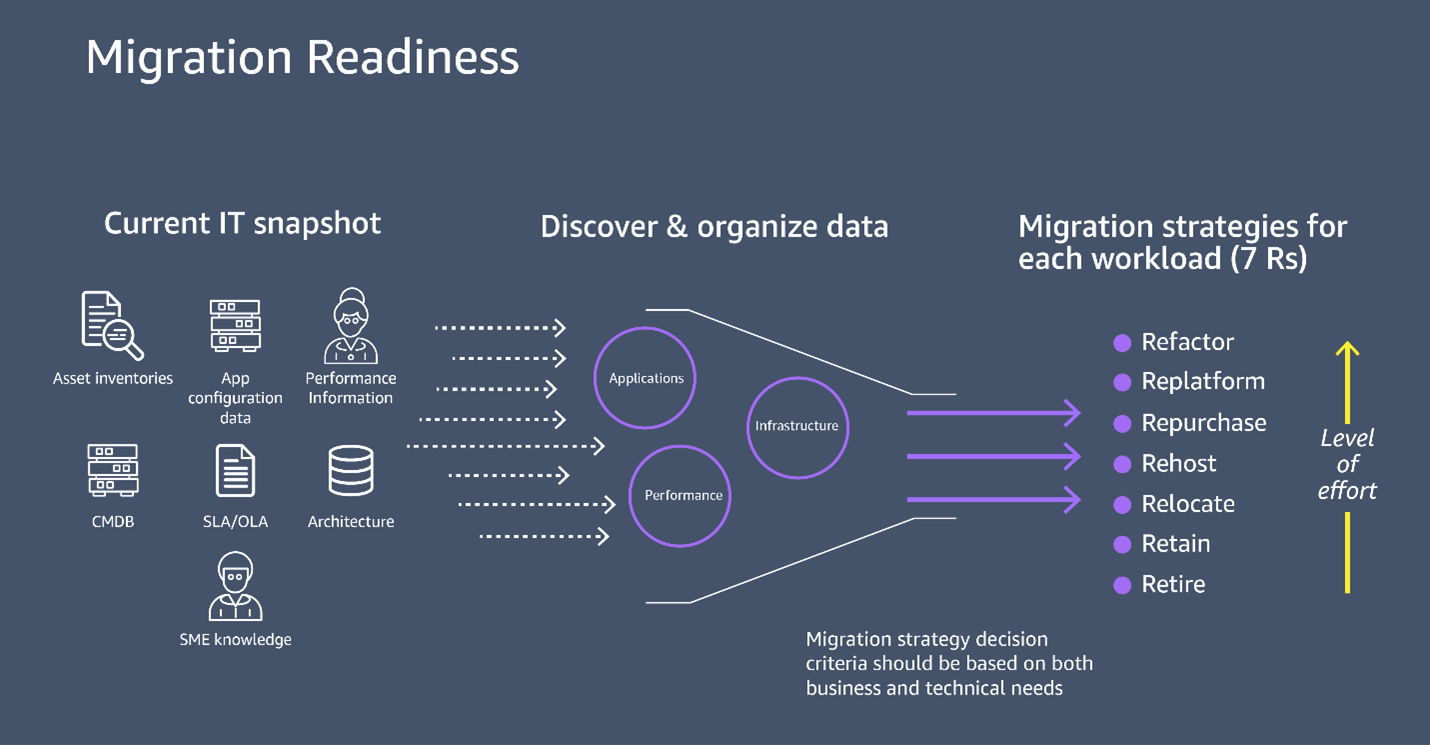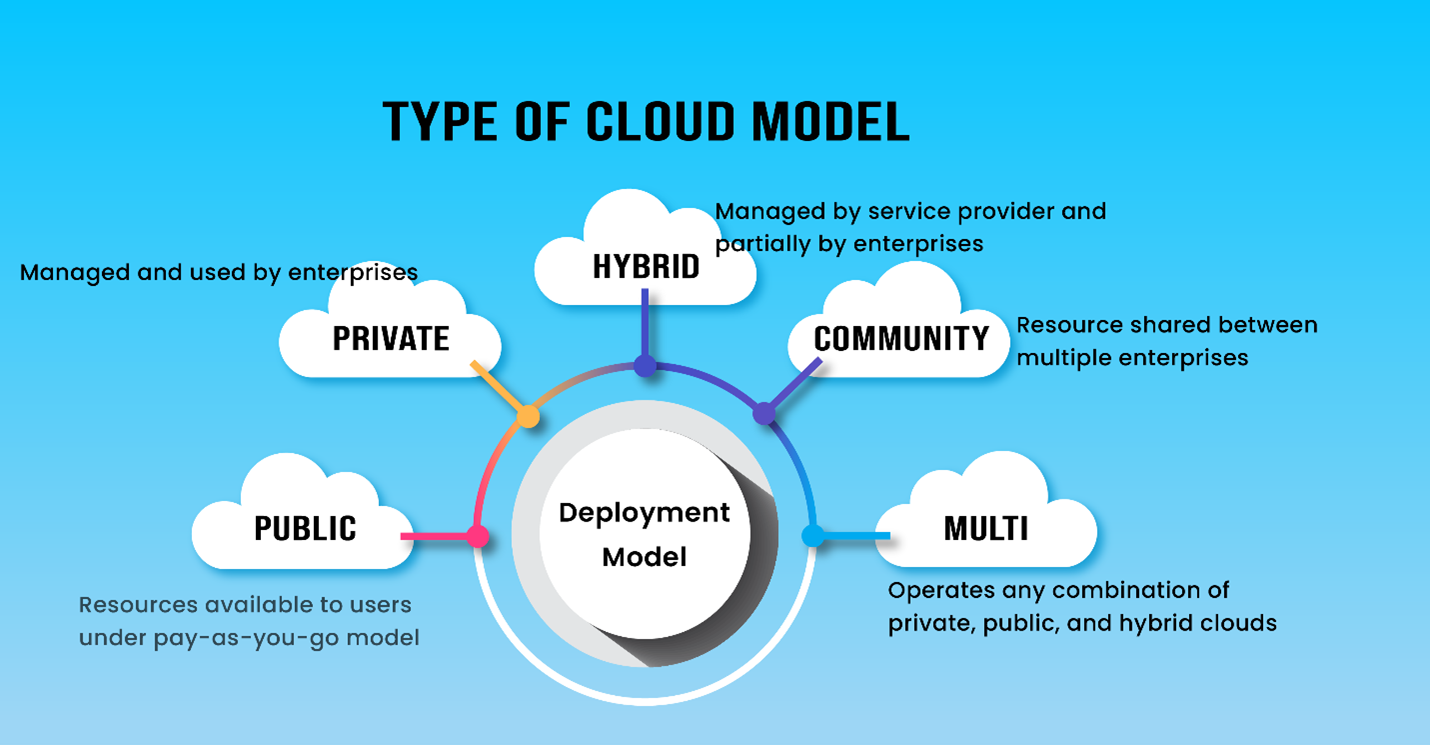Do more with less. Scalable. Agile. Whatever you call it, cloud computing is a technology that comes with a plethora of benefits. Cloud computing enables businesses to drop mundane and routine tasks and focus more on strategic ones driving innovation and growth. Well, cloud computing is not just about efficiency but a lot about unlocking limitless possibilities opening up in the digital era.
As corroborated by Gartner, 85% of organizations will go for a cloud-first approach by 2025. Adding to this, a LogicMonitor Cloud 2025 survey states that by 2025, 28% of corporate workloads will be in the public cloud, and 30% will be in the private cloud. While many enterprises are opting for public cloud adoption, it is essential to note that if migration does not happen the right way, it can not only jeopardize data integrity and hurt the budget but tarnish your business’s reputation.
Here is our insight into this migration from the private onsite premise to the public cloud migration – the emergence of Generative AI (GenAI) and Large Language Models (LLMs)! According to McKinsey, the use of generative AI is cutting down cloud migration efforts by 30% to 50% when done correctly.
Although, another earlier cloudshifter factor was the pandemic of 2019 that saw many companies struggling to provide access to vital data that was locked in silos on-premises. Realization dawned that shifting certain data and applications to the cloud could be beneficial for easy accessibility across the geospatial spectrum. So it won’t be wrong to say, the future of the public cloud is already at our doorstep in 2024!
These are just the stimulants!
The biggest motivator is Data, something that every industry across the globe churns out daily – an estimated a staggering 328.77 million terabytes of data come into existence daily. Thus far, organizations have been analyzing structured data for their business strategy or to meet customer demands. However, with the entry of GenAI and LLMs, data, both structured and unstructured, can now be analyzed in real time, resulting in better decision-making and bringing in creativity and innovation much faster.
Now for GenAI and LLMs to work on huge data sets, not all organizations can manage high-end servers on-premise or real-time access to clients or customers across the geo-temporal spectrum. Hence migrating to the public cloud becomes essential for easy accessibility along with a host of other benefits. Read the blog to understand the key factors enabling the private to public cloud migration.
Why Migrate to the Public Cloud?
Cloud migration put in simple terms is moving all your digital assets from their physical space to the cloud space. This means, data, databases, software systems, or applications, can be moved from on-premises servers, desktops, etc. to the cloud-hosted by a third-party agency like Amazon Web Services, Google, Microsoft, etc.
And here’s why we see the growing shift to hosting data and applications on the public cloud. The public cloud is far more scalable than most on-premises data centers. Its crucial support in terms of automation of large and complex workloads and its flexibility in response to user demand and quick access to data have proven its strong capabilities. Do read our Cloud Storage v/s On-premises Storage: A Comparative Analysis, for a more comprehensive picture when considering whether on-premise or cloud storage is better from a business strategy point of view to beat the market competition.
Cloud migration is gradually evolving from Cloud as a Technology Disruptor to Cloud as a Business Necessity, as explained in Figure 1.
Where do you see your organization in 2028?

Understanding the Basics of Private to Public Cloud Migration
Four words that define the migration from private to public cloud
FLEXIBILITY, SCALABILITY, EFFICIENCY, INNOVATION
However, if you have decided to shift from on-premises to cloud, to derive maximum benefits, three key considerations for a successful migration from private to public cloud need to be incorporated. A few foundational basic concepts need to be borne in mind.
The First Key Consideration: The 7Rs of Cloud Migration
Employ the simple approach to understanding the 7Rs of cloud migration as shown in Figure 2, which is essential to the organization’s strategy based on the business needs, technical challenges, and the desired outcome of the migration needed.
| Rs of Cloud Migration | Description | Benefits |
| Refactor/Re-architect | Here there is a need to change the application’s architecture to fully utilize cloud-native features | Suitable for businesses that look to add scalability, improve performance, or leverage advanced cloud capabilities. |
| Re-platform (Lift and Reshape) | In this approach, applications are moved to the cloud with minimal changes but are optimized to take advantage of certain cloud capabilities | It’s a middle ground between rehosting and refactoring.
|
| Repurchase (Drop and Shop) | Repurchase involves moving to a different product, often a cloud-native solution. | Similar to switching to a cloud-based version of an existing program or system that might offer greater features and efficiency.
|
| Rehost (Lift and Shift) | A Simple method that transfers current apps to the cloud without any changes. | Although it’s frequently the quickest migrating method, it doesn’t fully utilize cloud migration’s advantages. |
| Relocate (Hypervisor-Level Lift and Shift) | Similar to rehosting, except it’s specifically about migrating virtual machines to the cloud through hypervisors. | When the on-premises environment closely resembles the cloud environment, this strategy is usually employed.
|
| Retain (Revisit) | Holding on to certain applications on-premise rather than shifting to the cloud. | Depending on the confidentiality and security around it.
|
| Retire | Requires focus on critical sectors, while eliminating redundant information or data no longer useful.
|
To eliminate unwanted data |

The Second Key Consideration: Identify the 5 types of Cloud options to choose from:
There are five types of cloud options to choose as shown in Figure 3.

There are certain advantages for these cloud options as listed below influencing the organization to choose the most appropriate one.
- Private Cloud: Enhanced Security, Customization & Control, and Improved Performance
- Public Cloud: Scalability & Flexibility, Cost Efficiency, and Global Accessibility
- Hybrid Cloud: Flexibility & Agility, Data Control & Compliance, and Resource Optimization
- Multi-cloud: Redundancy & Resilience, Vendor Diversification, and Optimized Workload Placement
- Community Cloud: Cost-effective, Flexible, scalable, and sharing infrastructure
Third Key Consideration: Choosing the Right Cloud Services for the Cloud Deployment Models
Thirdly, an understanding of the major cloud services for cloud deployment models depending on business needs is important:
- Infrastructure as a Service (IaaS): IaaS provides virtualized infrastructure, a pay-as-you-go service for on-demand storage and networking services in the cloud. Examples: AWS EC2, Rackspace, Digital Ocean, and Google Compute Engine
- Platform as a Service (PaaS): PaaS offers a platform for applications maintained by the business. PaaS examples include a cloud-based software development platform or a container deployment/management platform. Examples: AWS Elastic Beanstalk, Heroku, and some Microsoft Azure services
- Software as a Service (SaaS): SaaS delivers cloud-based applications for access by business users. In the SaaS category, the cloud service provides users with access to one or more specific workloads, such as productivity applications like Microsoft’s Office 365. Using SaaS businesses leave the development, operation, and maintenance of the application to the provider. Examples: Salesforce, Dropbox, Slack and MailChimp.
All three cloud categories can be used concurrently in any combination that suits the business requirements.
How to Migrate: The Roadmap
Keeping the above key considerations can help move towards a successful Private to Public Cloud Migration based on business needs, cost-effectiveness, and changing business strategies. The major steps involved in the migration process are as follows:
- Decide on a Business Model
- Define Migration Strategy
- Estimate Costs
- Choose Cloud Type
- Choose Deployment Type
- Design the Architecture
- Define and Run Migration Steps
Now comes the crucial steps for a successful private-to-cloud migration.
Planning
- Define objectives and business goals upfront to make informed decisions about the type of cloud service provider and deployment model.
- Evaluate and assess current IT infrastructure, applications, and data: factor in the costs, risks, and dependencies.
- Manage costs effectively incorporating Flexibility: Shifting workloads between cloud providers or back to on-premises is a valuable strategy for cost optimization. Leverage multiple cloud services to prevent vendor lock-in.
- Employ a phased approach: Applications requiring additional work can be gradually refactored to optimize timelines and costs. This ensures a smoother transition and maximizes the economic benefits of cloud services.
Implementation
- Right Hosting Partner and deployment Model: either AWS Azure or Google Cloud.
- Rigorous Testing is essential for identifying and mitigating potential issues before they impact the production environment. Besides testing the functionality, performance, and security of the applications and data in the new cloud environment the migration plan also requires testing itself.
- Data migration is one of the most challenging aspects of cloud migration and requires careful planning and execution. The vigilance of which data needs to be migrated, transformed, and mapped needs to be addressed, and redundant data needs to be assessed to keep costs down.
- Networking is a critical component during migration. A clear understanding of networking requirements, including network security and its concerns need to be addressed.
Maintenance
- Plan for the safe storage and security of your data: Own the encryption keys or use a separate key provider to ensure an agnostic approach.
- Ensure Security and Compliance Policies and Processes: Address and monitor issues around data privacy.
- Ensure ongoing maintenance and monitoring are being done in-house or through an agency.
- Develop a disaster recovery and business continuity plan for the cloud environment, including backup and recovery strategies.
- Optimize cloud spending over time: Ongoing cloud costs can quickly add up if not managed properly. Develop a plan for how to manage costs and optimize cloud spending over time, including strategies such as monitoring usage, leveraging automation, and implementing cost-saving measures such as reserved instances and spot instances.
- Evaluate and select the right tools and technologies to support cloud migration, considering the organization’s specific requirements and the complexity of the workload environment.
Be Aware of the Challenges
Yes, migrating to the cloud can be a disruptive and complex process, no matter the size of the organization. There will always be a few challenges when using the public cloud that each organization will have to cross depending on their business needs and workloads:
- Lack of a Strategy: Business goals are important. If the 3 Key considerations are not part of your strategy, the entire shift could backfire.
- Technical Considerations: Check for power capacity, performance, utilization, security, and scalability. Failure of virtual compute instances, storage volumes, networking elements, and supporting services impacts the workload leading to migration failure. Ensure disaster recovery schemes are available. How many access points are available in groupings across regions, time zones, etc,
- Costs: The pay-per-use cost models can result in radically different costs to operate a workload
- Vendor Offers: Examine their track record, as well as the services offered. Ensure a good cloud exit strategy is provided.
- Confidentiality, Security & Compliance: Ensure data safety, integrity, consistency, and business continuity. Check for security and safety of authentication and authorization, and check for kinds of workloads that can be hosted in the public cloud.
- Cybersecurity: This is a looming threat but there are ways to mitigate them.
Post-Migration Maintenance: Continuous monitoring & checks, optimizing cloud spending, and ensuring usage align with budgetary constraints need to be monitored at all times.
Organizations that evaluate and approach cloud migration on an individual workload basis can make cogent decisions about cloud utilization in a way that is most beneficial to the organization.
Benefits of Migration
The transformative journey for a streamlined and successful private-to-public cloud migration depends on the planning, choice of the right cloud partner, and the 3 key considerations elucidated above. The benefits are immense.
Cloud is an enabler of digital business providing Flexibility: for geospatial teams this increases collaboration innovation, and Scalability: Respond to peak demands and lowers capacity automatically.
- Reduces operational burdens and addresses the geospatial spectrum with ease of deployment Reduces investment into high-end hardware and software accessories.
- Reduces data space and hosting costs.
- Reduces downtimes and lowers data loss risk.
- Competitive advantage with an increase in ROIs ensuring cost optimization.
- Better network latency.
- Higher security. According to Gartner’s predictions, up to 99% of cloud security failures through 2025 will be the customer’s fault.
Every organization using the public cloud needs to scale cloud resources to match business growth, integrate new services and tools given the digital dynamics, and continuously refine its cloud strategy to align with its evolving business objectives. By addressing these considerations, organizations will be well-prepared for a smooth transition to the public cloud! Remember that successful cloud migration involves a thoughtful approach, alignment with business objectives, and a focus on both technology and strategy.
In a Nutshell
For a streamlined and successful migration from private, or on-premises to public cloud migration, organizations need to team up with not just the service provider but also partner with organizations who can guide them given their expertise and experience.
We, at Calsoft, a Technology-First company and a pioneer in software product engineering services, take on the responsibility and commitment as a trusted partner and collaborator with expertise and experience in assessing, evaluating, and implementing the right fit for your cloudification and migration when required!
